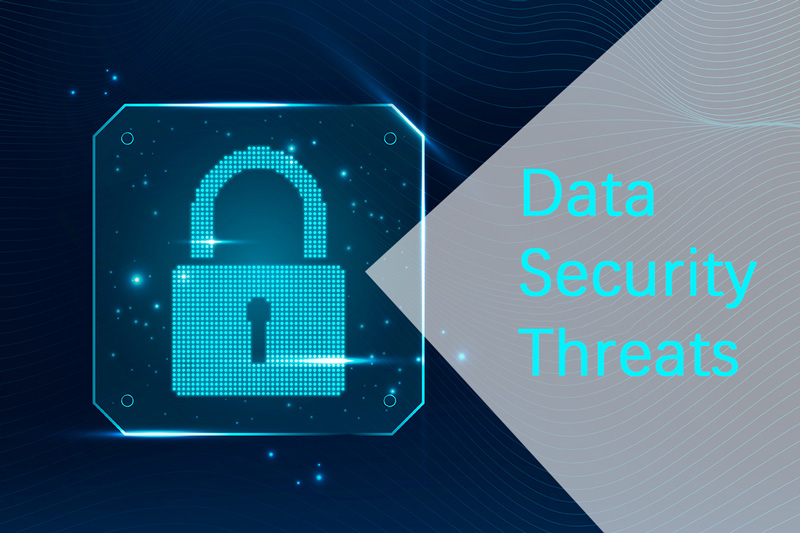Common Types of Data Security Threats
Data plays an imperative role in enhancing enterprise performance, boosting decision-making well, and stimulating innovation. However, unfortunately, there are myriad cons to this growing reliance on digital information as well. The most significant among them is the constant risk of data security breaches. This blog aims to explain the value of data as well as the urgent need for strong security measures to protect enterprises from harm. Here, we will discuss types of data security threats.
Before proceeding further, let us have little insight into the areas that need data protection.
1 Areas that Require Data Protection
1) Database
Nowadays, high volumes of sensitive data, including customer as well as company info, are stored in databases. If an unauthorized individual gains access to these databases, there could be serious results. For instance, access to employee databases with HR records as well as customer databases that contain personal info, can lead to financial loss as well as reputational damage.
2) Networks
Within enterprises, networks serve as the foundation for digital communication. Network security is crucial for preventing data interception and illegal access. Data security threats can affect both public networks that link distant workplaces and internal company networks that carry sensitive information.
3) Cloud Storage
Data saved in the cloud must be secured properly since cloud services are being used widely. Famous cloud storage platforms like Amazon S3, Google Drive, etc., often contain abundant sensitive data, including intellectual property, financial records as well as customer data.
4) Company Websites
Company websites are also susceptible to cyber threats, and data breaches. For instance, intruders can steal store payment details as well as customer's personal information from e-commerce websites. Hence, safeguarding these websites is pivotal for maintaining trust.
5) Applications
Applications handle and store sensitive data, whether they are internal or external. Enterprise apps oversee vital corporate operations, healthcare apps preserve patient data, and banking apps handle financial transactions. Maintaining the integrity of the data depends on the security of these apps.
6) Devices (Including IoT and Mobile Devices)
There are new issues brought about by the growth of mobile devices as well as Internet of Things (IoT) devices. These gadgets, which range from intelligent printers to staff cellphones, frequently have access to private information. In order to stop unwanted access, it is essential to make sure these endpoints are secure.
7) Documents
Documents, whether digital or physical, contain sensitive data. For example, contracts, court records, and internal reports. It is imperative to safeguard these records to avert any unapproved access, duplication, or alteration.

2 Common Types of Data Security Threats
Now, let us discuss common data security threats, which you should be aware of.
A. Threats to Network
1DDoS Attacks
Distributed Denial of Service (DDoS) attacks are planned efforts to stop a network or online service from operating normally by flooding it with excessive data. The target's resources are depleted by this traffic spike. This makes services sluggish, unresponsive, as well as completely unavailable in some cases.
2Man-in-the-Middle Attacks
The main aim of this type of attack is to disrupt or intercept the communication occurring between two parties.Without the communicating parties' awareness, the attacker surreptitiously transmits and could even modify the communication. The integrity and confidentiality of the information being transferred are seriously affected by thistype of data security threat.
3SQL Injection
Attackers inject SQL code to take advantage of vulnerabilities in the database layer of a website. Malicious SQL allows attackers to alter the database as well as get sensitive data without authorization. When online applications fail to properly verify or sanitize user inputs, attackers can execute arbitrary SQL code, making this threat potent.
4Eavesdropping
Unauthorized communication interception between two persons is called eavesdropping. Attackers use various techniques to eavesdrop on private discussions or data transfers. This danger is especially present in unprotected networks when no encryption is used for communication.
B. Threats to System and Software
5Malware
Malware is an abbreviation for malicious software. It is a broad category of destructive programs intended to compromise or harm computer systems. Worms, trojans, and viruses are common varieties that comprise Malware. Unauthorized access, system interruption, and data theft are all possible outcomes of Malware.
6Ransomware
Ransomware is another threat to data security. It's a cunning kind of Malware. User data is encrypted by ransomware, which blocks access until a ransom is paid. This sneaky threat jeopardizes data availability in addition to putting money at risk.
7Spyware
Software known as spyware secretly watches and gathers user data without the users' knowledge. Spyware frequently comes packaged with downloads that appear to be safe, but it has the ability to steal personal information and jeopardize important data, such as login passwords, resulting in privacy breaches and perhaps identity theft.
8Zero-Day Exploits
Zero-Day exploits aim to take advantage of undiscovered software flaws before the developers can fix them. Organizations have a significant issue when cybercriminals take advantage of security holes since there is no accessible protection or fix at the moment of attack. To reduce the dangers connected with Zero-Day exploits, vigilante security measures, frequent upgrades, as well as continuous monitoring are crucial.
C. Threats to Cloud Service
9Data Breaches
Unauthorized access to private data kept on cloud systems is referred to as a data breach in cloud services. These breaches, which may result from compromised credentials or system flaws, may expose private information as well as result in legal repercussions, and reputational harm.
10Insecure APIs
APIs (application programming interfaces) make it easier for a plethora of software systems to communicate with one another. Unauthorized access to data or the capacity for attackers to alter cloud services are two potential vulnerabilities that might arise from insecure APIs. To reduce this type of data security threat, API security and audits must be done on a regular basis.
11Account Hijacking
The practice of illegally accessing user accounts is called account hijacking. To pursue this, cybercriminals use weak passcodes or credentials to take control. This puts the user's data at risk and may also enable illegal usage of cloud services as well as resources.
12DoS Attack
Attacks known as denial of service (DoS) try to stop cloud services from being available to the users. This is done by flooding the cloud with traffic. Businesses' operations may be impacted by service outages caused by these attacks.
13Insider Threats
The act of malicious activity committed by members of an organization's own staff is called Insider Threats. Insiders can misuse their credentials to undermine cloud security; whether intentionally or accidentally.

D. Threats to Applications
14Cross-Site Scripting (XSS)
Malicious scripts are injected into web applications during XSS attacks, which may impact users who interact with the hacked application. Attackers compromise user trust as well as data integrity by using browser vulnerabilities to run scripts.
15Cross-Site Request Forgery (CSRF)
Cross-Site Request Forgery (CSRF) misleads users into unknowingly executing activities on authorized web apps. Attackers spoof requests to trick users into inadvertently carrying out malicious actions, which may result in unlawful transactions or changes to data.
16Insecure Direct Object References (IDOR)
When an application allows direct access to internal implementation objects, IDOR vulnerabilities can occur. Attackers may use this to gain unauthorized access to data, which might result in a threat to data security and the disclosure of private information.
17Session Vulnerabilities in Web App
Web applications are vulnerable to session related security issues, including session hijacking and session fixation. Attackers obtain unauthorized access to user accounts by taking advantage of session management vulnerabilities.
Threats to Physical
Threats like theft as well as manipulation can affect physical equipment likeservers, laptops, and mobile devices. Furthermore, data on stolen devices may be exposed. This emphasizes the necessity of rigorous security measures, including device monitoring as well as encryption to safeguard tangible assets.
3 Which Data Should Enterprises Prioritize for Data Protection?
To secure the most important assets, businesses need to prioritize their data protection operations properly. Creating a thorough data protection plan requires knowing which kinds of data require extra security measures.
Financial Information
Cybercriminals often keep their eye on financial data like credit card numbers and bank account information. Maintaining consumer confidence, as well as preventing fraud, requires the protection of financial transaction data, bank account information, and credit card numbers.
Intellectual Property
One of the vital components of a business's competitive edge is its intellectual property. Right? That's why It is crucial to safeguard sensitive info, including trade secrets, copyrights, as well as patents.
Personal Identifiable Information (PII)
PII should be the primary priority for data protection. This is because it includes data that may be used to identify specific persons, such as addresses, social security numbers, and other key identifiers.
Employee Information
Employee data, which includes payroll information and HR records, is an important asset that has to be well-protected.Data security threatsto employees' info may result in legal consequences.
Customer Data
Customer data, including contact information, preferences, as well as purchase history is vital for business to perform well. Therefore, safeguarding this data is imperative to preserving client confidence as well as the company's reputation.
Still need help? Submit a request >>


